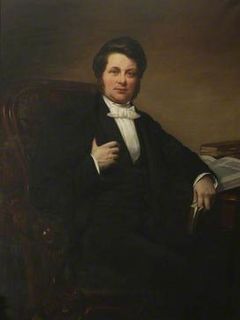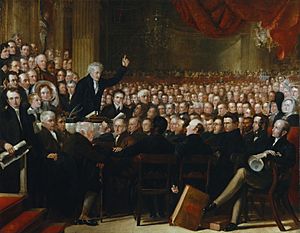William Brock (pastor) facts for kids
Quick facts for kids
William Brock
|
|
|---|---|

William Brock
|
|
| Born | 1807 |
| Died | November 13, 1875 (aged 67–68) |
| Resting place | Abney Park Cemetery in Stoke Newington, London. |
| Nationality | English |
| Occupation | watchmaker and pastor |
| Known for | Slavery abolitionist, Bible society |
William Brock (1807–1875) was an important English pastor, writer, and a strong supporter of ending slavery. He was the first minister at Bloomsbury Chapel in London from 1848 to 1872.
Contents
Growing Up and Becoming a Pastor
William Brock's family came from Holland many years ago. They moved to England in the 1500s to escape religious problems. William first worked as a watchmaker in a town called Hertford. He lived with a local pastor who inspired him to try helping people in the church.
Soon, Brock decided to stop making watches and become a full-time pastor. He studied at the Baptist College, Stepney. After graduating, he got a job at St Mary's Church in Norwich. He stayed there for 15 years. During this time, he often traveled to London to support the Missionary Society. This group helped spread Christianity around the world.
In 1848, William Brock was chosen to be the minister of the new Bloomsbury Chapel in Central London. This was a big deal because it was the first Baptist church built specifically for that area.
Life as a Minister
At Bloomsbury Chapel, William Brock was known for his warm and friendly speaking style. His sermons were different from those of another famous Baptist preacher, Charles Spurgeon. Spurgeon once said that Brock's speeches were "massive" and "rich in words," but also "homely, hearty, intense, overwhelming." He meant that Brock's words were powerful and comforting at the same time.
When William Brock turned 65, he decided to retire from his main job at Bloomsbury Chapel. Even though he was retired, he still wanted to help. He started working part-time for churches of all different Christian groups. He moved to Hampstead for the summers and spent winters in St. Leonards by the coast, where the air was fresh.
Writing Books and Biographies
William Brock had many interests outside of his church work. He was a member of the Peace Society, a group that was against war. Because of this, he did not support the Crimean War. However, he wrote a detailed book about General Sir Henry Havelock, who was also a Baptist and a soldier.
This book was published in 1857 and became very popular. But some of his friends and other Baptists were upset. They thought it was strange for a peace-loving Christian to write about a soldier.
Brock also wrote a very successful book about John Bunyan, who wrote "The Pilgrim's Progress." This book was also a best-seller and was included in many later editions of Bunyan's works.
Fighting Against Slavery
Besides his work with the Peace Society, William Brock was also very active in the movement to end slavery. This movement is called abolitionism. His name often appears in records of meetings held in England during the 1840s, 1850s, and early 1860s. These meetings supported ending slavery in the United States.
Brock was even a delegate at the world's first international Anti-slavery Convention in 1840. He can be seen in a famous painting of this event, which is now in the National Portrait Gallery in London.
Death and Resting Place
William Brock passed away in St. Leonard's on November 13, 1875. He was buried at Abney Park Cemetery in Stoke Newington, London.


